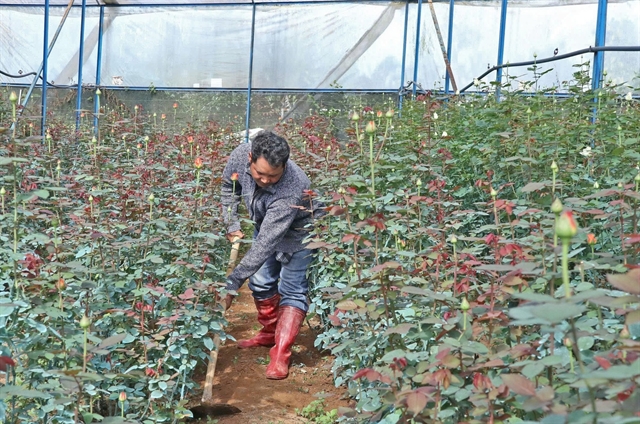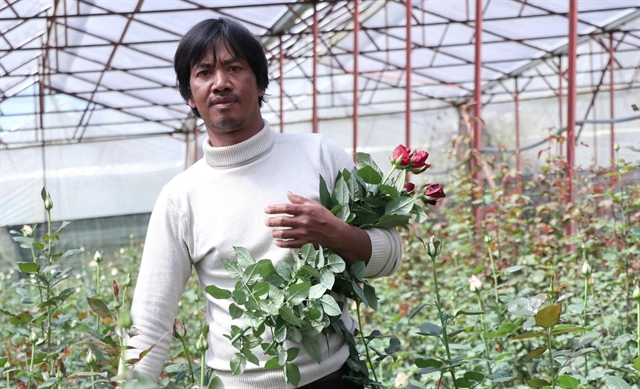October 21, 2025
HANOI – A high-tech rose cultivation model is transforming livelihoods for hundreds of K’Ho ethnic minority households in Lâm Đồng Province’s Central Highlands.
In the days leading up to Vietnamese Women’s Day (October 20), the rose-growing village at the foot of Langbiang Mountain was bustling with harvesting and trading activity. As prices rose and demand surged, local farmers were enjoying the profits.
At his greenhouse early in the morning, Bon Yô Soa busily cut roses for delivery to wholesalers in his garden in Đankia neighbourhood, Langbiang Ward.
With his 1,200sq.m. velvet rose garden, he harvests 600-700 stems every other day. At the current price of VNĐ3,500 (US$0.13) per stem during this season, his family earns around VNĐ2 million ($80) per day.

Bon Yo Soa receives loan support from the local farmers’ association to purchase seedlings, fertilisers and build a greenhouse for high-tech rose cultivation. PHOTO: VNA/VIET NAM NEWS
On regular days, when prices average VNĐ1,250 per stem, his family still maintains a stable monthly income of nearly VNĐ10 million ($380).
“After seeing many local farmers earn good profits from growing roses, I decided to learn and start my own garden. With support from the local Farmers’ Association, I received a loan to buy seedlings, fertilisers and build a greenhouse.
“This high-tech model has given my family a stable income and allowed my children to attend school,” Soa said.
Cil Ha Vit, also from Đankia, said that since switching from coffee to roses, his family had escaped unstable seasonal income.
With a 2,000sq.m. greenhouse, Ha Vit harvests 5,000-6,000 rose stems weekly, earning VNĐ5-6 million ($190-230) at an average of VNĐ1,000 per stem.
“After deducting expenses, our family earns over VNĐ10 million a month – a stable income that improves our quality of life,” he said.

Cil Ha Vit is one of the local farmers in Langbiang–Đa Lat Ward who has found success with high-tech rose farming. PHOTO: VNA/VIET NAM NEWS
This initiative is part of the 2021-2025 poverty reduction programme in Langbiang–Đà Lạt Ward. With access to the model and technical transfer, K’Ho people living at the foot of Langbiang Mountain now earn a steady livelihood and no longer face hunger or financial hardship.
Langbiang Ward covers over 322sq.km with a population of more than 40,000, of which ethnic minorities – mainly K’Ho Cil and K’Ho Lach – account for about 24.5 per cent, or nearly 10,000 people.
According to the Langbiang Ward People’s Committee, during the 2021-2025 period, the locality implemented multiple projects under the national target programme on sustainable poverty reduction in association with new-style rural development.
Livelihood diversification and production support projects have shown remarkable results, reducing the multidimensional poverty rate to only 0.01 per cent – with just one ethnic household classified as poor. There are also 30 near-poor households, mostly from ethnic groups.
The ward aims to eliminate poverty entirely by the end of 2025. However, with new multidimensional poverty standards to be applied for 2026-2030, local authorities are also developing plans to prevent poverty relapse among ethnic communities.
Hồ Công Định, Vice Chairman of Langbiang Ward’s Việt Nam Fatherland Front Committee and chairman of the local farmers’ association, said the locality had placed great emphasis on poverty alleviation in recent years.
The high-tech rose farming model had been a highlight of the local poverty reduction programme over the past five years, he said, helping hundreds of households, including many ethnic minority families, escape poverty.
He added that the ward would continue coordinating with provincial agencies to expand support for capital, plant varieties and farming techniques.
While the model demands both high technical skills and significant initial investment, it brings high economic efficiency and a stable income, helping local people achieve sustainable livelihoods, according to Định.


